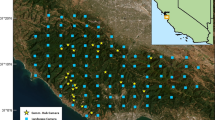Abstract
Prey are often consumed by multiple predator species. Predation rates on shared prey species measured in isolation often do not combine additively due to interference or facilitation among the predator species. Furthermore, the strength of predator interactions and resulting prey mortality may change with habitat type. We experimentally examined predation on amphipods in rock and algal habitats by two species of intertidal crabs, Hemigrapsus sanguineus (top predators) and Carcinus maenas (intermediate predators). Algae provided a safer habitat for amphipods when they were exposed to only a single predator species. When both predator species were present, mortality of amphipods was less than additive in both habitats. However, amphipod mortality was reduced more in rock than algal habitat because intermediate predators were less protected in rock habitat and were increasingly targeted by omnivorous top predators. We found that prey mortality in general was reduced by (1) altered foraging behavior of intermediate predators in the presence of top predators, (2) top predators switching to foraging on intermediate predators rather than shared prey, and (3) density reduction of intermediate predators. The relative importance of these three mechanisms was the same in both habitats; however, the magnitude of each was greater in rock habitat. Our study demonstrates that the strength of specific mechanisms of interference between top and intermediate predators can be quantified but cautions that these results may be habitat specific.




Similar content being viewed by others
References
Byers JE (2002) Physical habitat attribute mediates biotic resistance to non-indigenous species invasion. Oecologia 130:146–156
Chesson P, Rosenzweig M (1991) Behavioral, heterogeneity, and dynamics of interacting species. Ecology 72:1187–1195
Crumrine PW, Crowley PH (2003) Partitioning components of risk reduction in a dragonfly-fish intraguild predation system. Ecology 84:1588–1597
Eklov P, VanKooten T (2001) Facilitation among piscivorous predators: Effects of prey habitat use. Ecology 82:2486–2494
Finke DL, Denno RF (2002) Intraguild predation diminished in complex-structured vegetation: implications for prey supression. Ecology 83:643–652
Gause GF (1934) The struggle for existence. Williams and Wilkins, Baltimore
Grabowski JH (2004) Habitat complexity disrupts predator-prey interactions but not the trophic cascade on oyster reefs. Ecology 85:995–1004
Grabowski JH, Powers SP (2004) Habitat complexity mitigates trophic transfer on oyster reefs. Mar Ecol-Progress Ser 277:291–295
Harvey BC, White JL, Nakamoto RJ (2004) An emergent multiple predator effect may enhance biotic resistance in a stream fish assemblage. Ecology 85:127–133
Huffaker CB (1958) Experimental studies on predation: dispersion factors and predator–prey oscillations. Hilgardia 27:343–383
Jackson EL, Rowden AA, Attrill MJ, Bosse SJ, Jones MB (2001) The importance of seagrass beds as a habitat for fishery species. Oceanograph Mar Biol Annu Rev 39:269–303
Jensen GC, McDonald PS, Armstrong DA (2002) East meets west: competitive interactions between green crab Carcinus maenas, and native and introduced shore crab Hemigrapsus spp. Mar Ecol Progress Ser 225:251–262
Lang A (2003) Intraguild interference and biocontrol effects of generalist predators in a winter wheat field. Oecologia 134:144–153
Lima SL (1998) Stress and decision making under the risk of predation: recent developments from behavioral, reproductive, and ecological perspectives. Adv Study Behav 27:215–290
Lipcius RN, Hines AH (1986) Variable functional response of a marine predator in dissimilar homogeneous microhabitats. Ecology 67:1361–1371
Lohrer AM, Whitlatch RB (2002) Interactions among aliens: apparent replacement of one exotic species by another. Ecology 83:710–732
Lohrer AM, Whitlatch RB, Wada K, Yasuo F (2000) Home and away: comparison of resource utilization by a marine species in native and invaded habitats. Biol Invas 2:41–57
Losey JE, Denno RF (1998) Positive predator-predator interactions: Enhanced predation rates and synergistic suppression of aphid populations. Ecology 79:2143–2152
Marshal SD, Rypstra AL (1999) Spider competition in structurally simple ecosystems. J Arachnol 27:343–350
McDermott JJ (1998) The western Pacific brachyuran Hemigrapsus sanguineus (Grapsidae) in its new habitat along the Atlantic coast of the United States: feeding, cheliped morphology and growth. In: von Vaupel Klein JC (ed) Crustaceans and the biodiversity crisis. Brill, Leiden, pp 425–444
Norton AP, English-Loeb G, Belden E (2001) Host plant manipulation of natural enemies: leaf domatia protect beneficial mites from insect predators. Oecologia 126:535–542
Roda A, Nyrop J, Dicke M, English-Loeb G (2000) Trichomes and spider-mite webbing protect predatory mite eggs from intraguild predation. Oecologia 125:428–435
Sietz RD, Lipcius RN, Hines AH, Eggleston DB (2001) Density-dependent predation, habitat variation, and the persistence of marine bivalve prey. Ecology 82:2435–2451
Sih A, Englund G, Wooster D (1998) Emergent impacts of multiple predators on prey. Trends Ecol Evol 13:350–355
Soluk DA (1993) Multiple predator effects - predicting combined functional-response of stream fish and invertebrate predators. Ecology 74:219–225
Swisher BJ, Soluk DA, Wahl DH (1998) Non-additive predation in littoral habitats: influences of habitat complexity. Oikos 81:30–37
Tyrrell MC, Harris LG (1999) Potential impact of the introduced Asian shore crab Hemigrapsus sanguineus, in northern New England: diet, feeding preferences, and overlap with the green crab, Carcinus maenas. In: Pederson J (ed) Proceedings of the national conference on marine bioinvasions, pp 208–220
Vance-Chalcraft HD, Soluk DA (2005) Multiple predator effects result in risk reduction for prey across multiple prey densities. Oecologia (in press)
Warfe DM, Barmuta LA (2004) Habitat structural complexity mediates the foraging success of multiple predator species. Oecologia 141:171–178
Werner EE, Peacor SC (2003) A review of trait-mediated indirect interactions in ecological communities. Ecology 84:1083–1100
Woodley CM, Peterson MS (2003) Measuring responses to simulated predation threat using behavioral and physiological metrics: the role of aquatic vegetation. Oecologia 136:155–160
Acknowledgments
Thanks to I. Altman, A. Blakeslee, J. Dijkstra, A. Freeman, J.H. Grabowski, S. Kohler, J. Leff, J. Meyer, O.J. Schmitz, S. Teck, and two anonymous reviewers for critiques of the manuscript. This research was partially funded by the University of New Hampshire Center for Marine Biology. The experiments described here comply with the current USA laws.
Author information
Authors and Affiliations
Corresponding author
Additional information
Communicated by Steve Kohler
An erratum to this article can be found at http://dx.doi.org/10.1007/s00442-005-0272-4
Rights and permissions
About this article
Cite this article
Griffen, B.D., Byers, J.E. Partitioning mechanisms of Predator Interference in different Habitats. Oecologia 146, 608–614 (2006). https://doi.org/10.1007/s00442-005-0211-4
Received:
Accepted:
Published:
Issue Date:
DOI: https://doi.org/10.1007/s00442-005-0211-4




